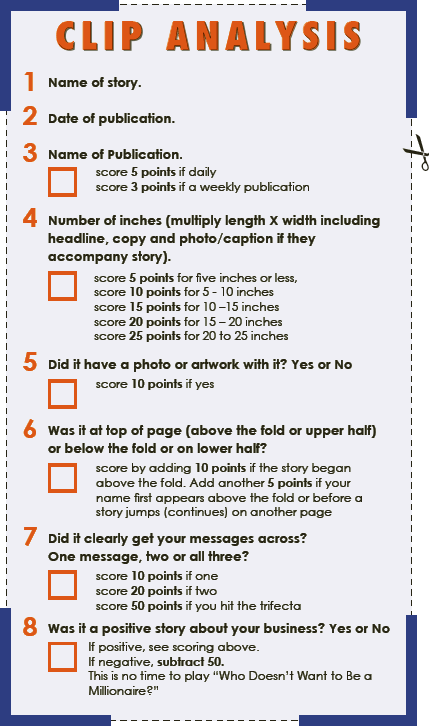What Is Your PR Score
 Public relations exposure extends beyond newspaper, radio and television mentions. Take the test now to find out how your company measures up.
Public relations exposure extends beyond newspaper, radio and television mentions. Take the test now to find out how your company measures up.
There are several sayings that are commonly referred to when talking about obtaining public relations exposure, mostly as it applies to getting your name in the newspaper or heard on television or radio. Unfortunately, living by most of these adages won’t help you or your business.
“There is no such thing as bad press!” Sure there is. The media may expose improper personal or corporate behavior or hasten the demise for individuals and companies already under siege. The list of examples has grown exponentially.
“I don’t care what they say as long as they spell my name right!” Sure you do. See above!
“Just guarantee that you can get me in the New York Times, USA Today and Time Magazine!” Sure we can. Just let us know the day, time and location of when you plan on committing a mass criminal offense.
None of the aforementioned are acceptable attitudes or actions.
Public relations is, at best, a strategic discipline, the benefit of which should be two-fold—increasing sales and enhancing the asset value of your business. Both can be accomplished. While we don’t always recommend this be solely attempted by those not educated and skilled in the art of public relations and attaining exposure, we are providing an abridged version of the Minkus Media Relations Management & Results System for those that want to play along in home or office. For our purposes, we will call this MRMRS Lite.
The following provides a simple method in which you can build public relations into your business with a goal of generating positive results—more sales and greater asset value. Moreover, the MRMRS Lite approach can be easily integrated, with preferably a small team of two to four staff sharing responsibility.
There are no top hats, thimbles or race cars in this game; however, the game requires subscriptions to your local daily and weekly newspapers, a telephone and computer with E-mail capability. It also requires an open mind willing to try something in the best interest of your business. Furthermore, it is beneficial if you enjoy gamesmanship and are especially adroit at contests focused on sinking the competition.
Integrating public relations into your operations is a good addition. Start simple and over the months, PR can become a better business practice.
Now, the contest begins. Remember, you are playing against two measurements – yourself and your competition. The goal is to turn in the highest score after six months. Specifically, you will try to get as many positive articles in your local daily and weekly newspapers as possible. You will see, as the game progresses, how this strategically evolves.
Month one:
- Build your team of two to four participants.
- Make certain subscriptions to the local dailies and weeklies are delivered to your office.
- Assign the reading of these papers to your team.
- Read your local daily and weekly newspapers.
- Clip all articles mentioning your business or your competitors.
- Tally how many articles they had and how many you had.
Month two:
- Continue to read your local daily and weekly newspapers, clipping all articles mentioning your business or your competitors and tallying the number of all.
- Month two, week one: Write down three messages you want to get across about your business every time you talk to a prospective client, referral source or are in contact with the media, either by interview or news release.
- Month two, week two: Contact your local newspapers and get the names, phone number and E-mail addresses for the business news editor, beat reporter who may cover your industry and reporters who have written articles about you, your company and/or your competitors.
- Month two, week three: Send thank you notes if you received favorable mentions from reporters and in the note include the three messages and an invitation to contact you again when they need input on a topic or are considering a feature story.
- For others, send a letter of introduction to the editors and reporters and in the note include the three messages and an invitation to contact you again when they need input on a topic or are considering a feature story.
- Month two, week four: Put together a list of three to five items you believe are of “news” interest regarding your business. Those items might include news about new hires, new or enhanced products or services, addition or expansion of locations or maybe receipt of an award.
Month three:
- Continue to read your local daily and weekly newspapers, clipping all articles mentioning your business or your competitors and tallying the number of all.
- Complete first two month benchmark of articles written about your firm or competitors and what messages they got across.
- Send out at least two news releases, weeks one and three.
- Send thank you notes if you received favorable mentions from reporters and in the note include the three messages and an invitation to contact you again when they need input on a topic or are considering a feature story.
Month four:
- Continue to read your local daily and weekly newspapers, clipping all articles mentioning your business or your competitors and tallying the number of all.
- Send out at least two news releases, weeks one and three.
- Send thank you notes if you received favorable mentions from reporters and in the note include the three messages and an invitation to contact you again when they need input on a topic or are considering a feature story.
- Complete second two month benchmark and compare score. You now have two comparisons of two-months each, the first two months when you presumably had not initiated MRMRS Lite and second two-months when the system had been activated. You are ready to advance.
Month five:
- Continue to read your local daily and weekly newspapers, clipping all articles mentioning your business or your competitors and tallying the number of all.
- Now, track messages that appeared in articles. What messages came across in articles mentioning competitors and what messages did you get across?
- Begin goal setting for balance of year by quantity of articles and where you would like them to appear; by number of articles vs. competition; by messages you were able to get across and messages they got across.
- Continue sending two releases per month if possible.
- Send thank you notes if you received favorable mentions from reporters and in the note include the three messages and an invitation to contact you again when they need input on a topic or are considering a feature story.
Month six:
- Continue to read your local daily and weekly newspapers, clipping all articles mentioning your business, or your competitors, and tally the number of all. Track messages that appeared in articles – the messages that came across in articles mentioning competitors and the messages that you got across. Continue sending two releases per month if possible.
- Send thank you notes if you received favorable mentions from reporters and in the note include the three messages and an invitation to contact you again when they need input on a topic or are considering a feature story.
- Complete second third two-month benchmark and compare scores to the first and second two-month periods.
At the conclusion of six months:
Here is where the analysis becomes even more strategic and beneficial. Gather all of the clips for the first six months, yours and your top two or three competitors. We are going to see just how well you are doing!
Start with your clips and complete a form for each story.

Upon completing your clip analysis, total the number of clips and then add the scores for each clip to come up with a six month total. Now, look at each competitor and use the same scoring formula as above. Use your messages for your competitors. See how they may have used the same messages. Compare your scores to competitors. Use this information for future planning and continue to build good habits.







